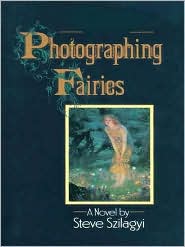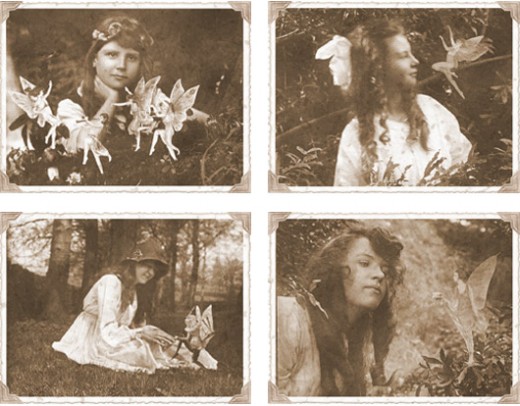
I found a couple of faerie-related books at a library book sale I had never heard of before.
The first was Photographing Fairies by Steve Szilagyi...which I also just found out has been made into a movie, which seems to have pretty good reviews.
The novel's inside flap promises to take the reader back in time to the 1920s and see the story of the Cottingley Fairies through the eyes of a young photographer. Sir Aurthur Conan Doyle figures in as a character- he was a believer in the photographs himself, and I like historical fiction that blends as much fact as possible in.
I assumed the novel would prove to us that the Cottingly Fairy hoax was actually true, and it was proved by this photographer, which seemed interesting enough, but the book actually skims over the Cottingley Fairies and concentrates on a competitive (fictional) set of photographs, which also happened to involve two girls in a garden. But I'm glad that the premise of the book was not to make the hoax true-although the pictures are pretty impressive considering that the fairies were drawn by a 16-year old and 10-year old girl, I agree with Szilagyi's assessment of them: "Your pictures are crude concoctions pandering to the popular idea of what a fairy is supposed to look like. Look, this fairy here is wearing a gown. Where did she get that? Are there fairy dress shops? Are there fairy mills where they weave the fabric? And who works in the mills and dress shops?...what I do know is that if there are fairies, they don't look like popular illustrations. They'll look how they look. Not how we want them to look."

Cottingley Fairy Photographs
The novel was entertaining but I especially enjoyed Szilagyi's interesting ideas on what a separate race of people could be and the implications of discovering such a thing. The fairies as we see them in the book are still diminuitive and we don't ever discover if they are a complex, powerful group of beings such as in true fairie lore or a simple-minded, cute garden adornment hardly any different than butterflies (or the Tinker Bell fairy of the popular imagination). At least Szilagyi leaves you to ponder the possibilities yourself.
I also really enjoyed this passage, from when the main character, Castle, is still unsure as to if the fairies actually exist or not and another character gets stung by a bee: "Templeton's sting was a rebuke from nature. While we search the garden for tiny, imaginary versions of ourselves, we miss entirely the more fantastic creatures that crowd there, more mysterious and impenetrable than any parallel universe of floating fays."

Interestingly, the year the movie for this book came out was the same year Fairy Tale: A True Story came out, a movie about the Cottingley Fairies, represented as a true story. My mom rented that movie for me once when I was sick and even being younger, I resented them misusing the phrase "True story", for I knew it wasn't true although I knew none of the details at that point. The story was "true" in that there really was an incident, but not in the sense that the fairies were real as the movie portrayed. However, for those who still want to believe, this is the final photograph that Frances insisted was genuine, even though Elsie claimed it was also a fake.

This interesting quote came from Frances at the end of her life: "I never even thought of it as being a fraud – it was just Elsie and I having a bit of fun and I can't understand to this day why they were taken in – they wanted to be taken in."

No comments:
Post a Comment